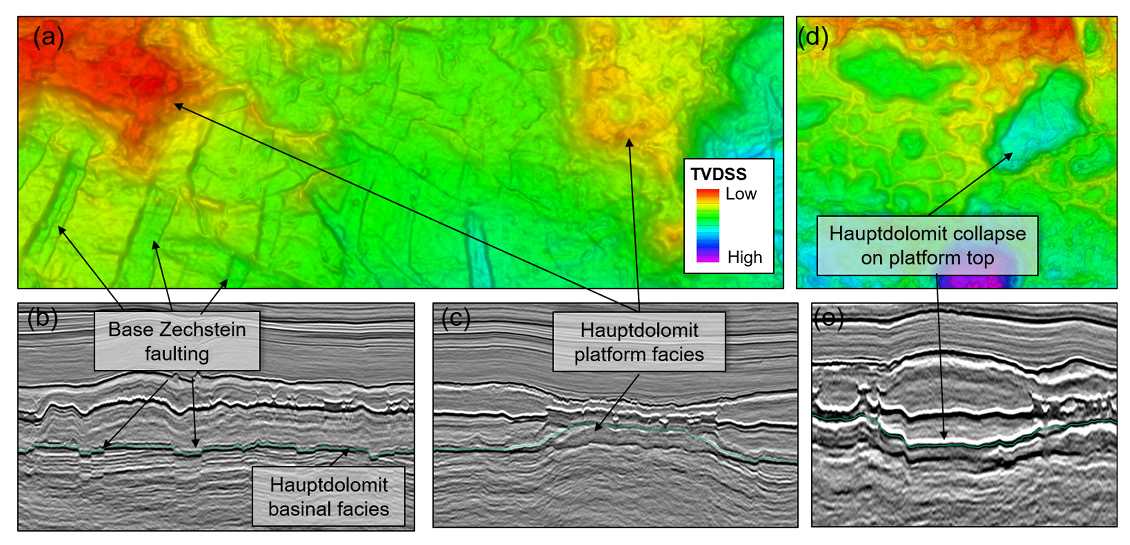
The Zechstein: an ignored and bypassed play
Exploration in the Southern North Sea (SNS) and on the Mid North Sea High (MNSH) area has focused on the clastic plays of the Lower Permian Rotliegend Group and earlier Carboniferous units in dominantly structural traps. The Zechstein, in contrast, is typified by multiple thin dolomite units within a dominantly anhydrite and halite sequence with variable reservoir facies and with complex geometries (Figure 2). With seismic quality unable to easily resolve reservoir variability, it was not the primary target for exploration, also meaning that wells through the Zechstein unit were neither aimed at the most prospective parts, nor significantly investigated.
However, there are several hints toward the potential of this unit. But exploration efforts are hampered by a lack of large, modern, high-quality 3D seismic in the most prospective areas of the play. The ION MNSH PRIME 3D is therefore critical to imaging these complex repeating units, their lateral variability and building an understanding of reservoir distribution and prospectivity.
Time to reconsider
In the UK 32nd round, 40% of the acreage was awarded in the SNS. The UK remains an attractive area for investment with one of the highest global returns per barrel. The presence of existing infrastructure, the location of future CCS (e.g., Endurance) and the location of windfarm development (e.g., Sofia and Dogger Bank), all help to lower the carbon footprint for oil and gas while maintaining profitability, making the SNS an area of industry focus.
The geology also favors the SNS/MNSH area to demonstrate the potential in the Zechstein, especially the Z2 Hauptdolomit unit (inset Figure 2). One of the earliest discoveries offshore in the SNS was Resolution (1966) which found oil in the Z2 Hauptdolomit just offshore Yorkshire. While reservoir quality was poor and the discovery remains undeveloped, Shell have recently farmed-in with a view to further appraisal and potential development.
In 1990, the Crosgan discovery, whilst mainly targeting Carboniferous, discovered gas in the Hauptdolomit. In 2019, the Ossian discovery (Figure 1) tested oil in the Hauptdolomit and will be ready for appraisal in early 2022, and onshore UK, the West Newton oil discovery was made in the same unit, targeting the platformal facies to optimize reservoir quality.
All these results and those on the margin of the Permian basin demonstrate that the Hauptdolomit is an attractive target with excellent reservoir properties in areas of platformal facies. The identification of these platform facies from the less prospective basinal facies, requires regional high quality 3D seismic to fully constrain the distribution. IONs MNSH PRIME 3D survey enables the explorer to do just this.
Spectacular initial results
Imaging of the first phase of the MNSH PRIME 3D is in progress, using a full range of modern processing and imaging techniques. Initial results show a significant improvement in imaging quality over previous datasets. Figures 3–5 show sections and horizon maps of the Top Zechstein, Plattendolomit (Z3) and Hauptdolomit (Z2) respectively.
The Top Zechstein (Figure 3) shows varying amounts of halokinesis causing collapse and thickening of the overlying Bacton group Triassic strata, itself a potential target. The initiation of these collapse features is inherently related to the edges of the more platformal seismic facies units in the lower Zechstein, highlighting that movement is initiated where there are rapid changes in the amount of halite in the section.
The Z3 Plattendolomit unit is a strong seismic marker but is variable across the area (Figure 4). Where the platformal zones dominate, and the overall Zechstein is thinner in the east, the Plattendolomit is characterized by karstification and the presence of sinkhole-type features. These are not seen further west where there is a thicker sequence and the Plattendolomit is surrounded by more halite-rich units. Here we see more gentle, salt-cored ridges and no evidence for exposure or karstification. Note that the ridges form early and are layer bound.
The Z2 Hauptdolomit (Figure 5), is more enigmatic seismically but is a critical horizon to pick accurately; it is the most prospective reservoir unit where it is a more elevated, thicker platformal facies, proven by previous successes. Additionally, where it is a more basinal facies it has also been demonstrated to be an effective source rock, the ‘Stink-dolomite’. In the west of the survey, the platform edge is well picked out seismically defining potential targets; in the east we see more erosion and collapse in this unit, giving the potential for karstified secondary porosity development.
Overall, our initial results from this exciting new dataset show how high quality data can illuminate and unlock the potential of this previously largely overlooked play in the UKCS.







